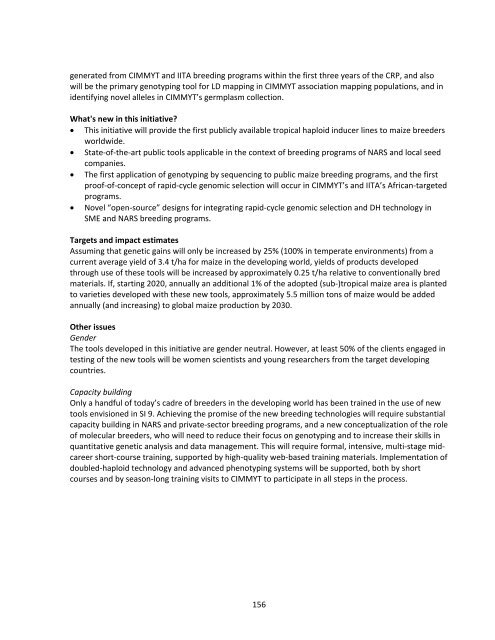Download - Maize
Download - Maize
Download - Maize
You also want an ePaper? Increase the reach of your titles
YUMPU automatically turns print PDFs into web optimized ePapers that Google loves.
generated from CIMMYT and IITA breeding programs within the first three years of the CRP, and also<br />
will be the primary genotyping tool for LD mapping in CIMMYT association mapping populations, and in<br />
identifying novel alleles in CIMMYT’s germplasm collection.<br />
What's new in this initiative?<br />
This initiative will provide the first publicly available tropical haploid inducer lines to maize breeders<br />
worldwide.<br />
State‐of‐the‐art public tools applicable in the context of breeding programs of NARS and local seed<br />
companies.<br />
The first application of genotyping by sequencing to public maize breeding programs, and the first<br />
proof‐of‐concept of rapid‐cycle genomic selection will occur in CIMMYT’s and IITA’s African‐targeted<br />
programs.<br />
Novel “open‐source” designs for integrating rapid‐cycle genomic selection and DH technology in<br />
SME and NARS breeding programs.<br />
Targets and impact estimates<br />
Assuming that genetic gains will only be increased by 25% (100% in temperate environments) from a<br />
current average yield of 3.4 t/ha for maize in the developing world, yields of products developed<br />
through use of these tools will be increased by approximately 0.25 t/ha relative to conventionally bred<br />
materials. If, starting 2020, annually an additional 1% of the adopted (sub‐)tropical maize area is planted<br />
to varieties developed with these new tools, approximately 5.5 million tons of maize would be added<br />
annually (and increasing) to global maize production by 2030.<br />
Other issues<br />
Gender<br />
The tools developed in this initiative are gender neutral. However, at least 50% of the clients engaged in<br />
testing of the new tools will be women scientists and young researchers from the target developing<br />
countries.<br />
Capacity building<br />
Only a handful of today’s cadre of breeders in the developing world has been trained in the use of new<br />
tools envisioned in SI 9. Achieving the promise of the new breeding technologies will require substantial<br />
capacity building in NARS and private‐sector breeding programs, and a new conceptualization of the role<br />
of molecular breeders, who will need to reduce their focus on genotyping and to increase their skills in<br />
quantitative genetic analysis and data management. This will require formal, intensive, multi‐stage midcareer<br />
short‐course training, supported by high‐quality web‐based training materials. Implementation of<br />
doubled‐haploid technology and advanced phenotyping systems will be supported, both by short<br />
courses and by season‐long training visits to CIMMYT to participate in all steps in the process.<br />
156

















